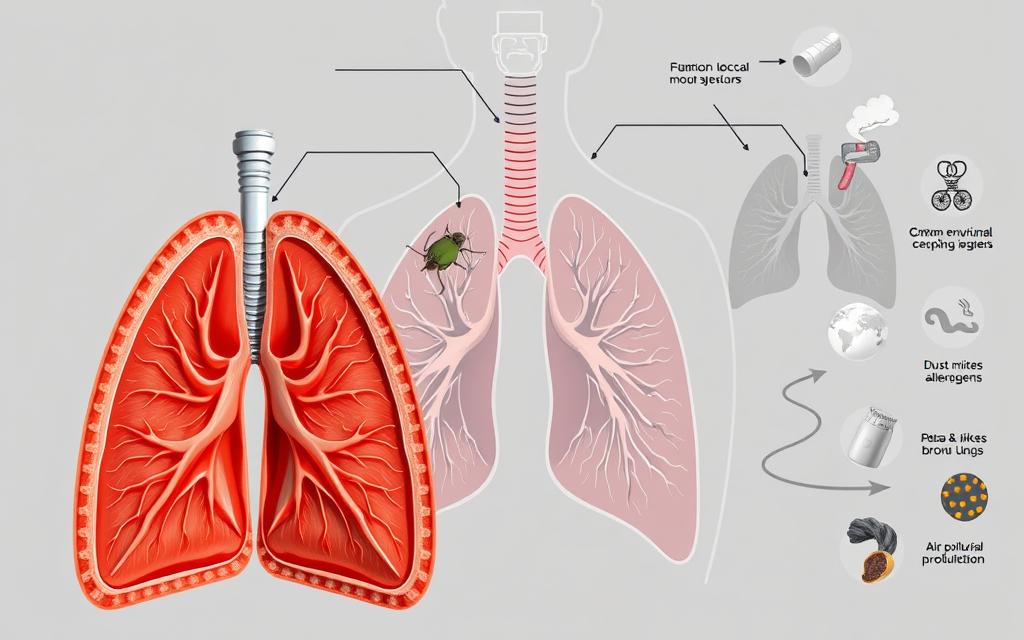Living with asthma is like a daily fight. We always watch our breathing, knowing it’s hard sometimes. It’s not just about the medical terms; it’s about how asthma changes our lives.
We’ve all had moments when breathing felt hard. Simple tasks became tough. So, it’s key to learn about asthma. We need to know its symptoms and triggers to find good treatments and ways to manage it.
Let’s dive into the important parts of asthma. This way, we can not just get by, but really live well.
Key Takeaways
- Asthma is a chronic lung condition affecting millions in the U.S.
- Understanding asthma symptoms is vital for effective management.
- Identifying triggers can significantly reduce the risk of asthma attacks.
- Medications and inhalers are critical components of asthma treatment.
- Creating an action plan helps in managing the condition more effectively.
- Regular check-ups are essential for long-term asthma management.
What is Asthma?
Asthma is a long-term lung disease that makes breathing hard. It causes symptoms like shortness of breath, wheezing, and tightness in the chest. Knowing about asthma means understanding its definition and types.
Definition and Overview
Asthma affects millions of people around the world. It makes the airways narrow and swell, leading to more mucus. This makes breathing in and out of the lungs hard. But, with the right care, people with asthma can live full and active lives.
Types of Asthma
Knowing about the different types of asthma helps us understand it better. Each type has its own triggers and symptoms. This affects how we treat it. Here’s a quick look at the main types of asthma:
| Type of Asthma | Description | Common Triggers |
|---|---|---|
| Allergic Asthma | Caused by allergens like pollen, pet dander, or dust mites. | Dust mites, pollen, pet dander, molds. |
| Non-Allergic Asthma | Caused by non-allergic factors like weather changes or stress. | Strong odors, cold air, exercise. |
| Exercise-Induced Asthma | Happens during or after exercise. | Cold weather, prolonged exercise. |
| Occupational Asthma | Caused by specific irritants at work. | Chemicals, dust, fumes, animal dander. |

Learning about these asthma types helps us manage it better. Knowing our specific type can improve our health and quality of life.
Common Asthma Symptoms
It’s important to know about asthma symptoms for those who have it and their families. Asthma can show up in different ways, making it hard to understand its impact. Common signs include shortness of breath, wheezing, a chronic cough, and feeling tight in the chest. Spotting these symptoms early can help manage the condition better and make us feel more comfortable.
Identifying Key Symptoms
Key symptoms of asthma often present as:
- Shortness of breath: This symptom can make it hard to do physical activities.
- Wheezing: A high-pitched whistling sound during exhalation usually means airway constriction.
- Cough: A persistent cough, especially at night or early morning, may signal an asthma flare-up.
- Chest tightness: This feels like pressure or a band around the chest.
How Symptoms Vary Among Individuals
Symptoms of asthma can differ from person to person. Some might have mild symptoms less often, while others face ongoing issues. Triggers can include physical activity, cold air, or specific allergens, making symptoms worse. By tracking these differences, we can understand our condition better and take a more active role in managing our health.

Understanding Asthma Triggers
Knowing what triggers asthma is key to managing it well. Many things can set off symptoms, so it’s crucial to understand them. Both things in our environment and physical activities can make asthma worse. Let’s look at some common triggers.
Common Environmental Triggers
Environmental allergens are big asthma triggers. Knowing what they are helps us stay away from them. Here are some common ones:
- Pollen from trees, grasses, and flowers
- Dust mites in bedding and furniture
- Pet dander from cats, dogs, and other animals
- Mold spores in damp places
- Cold air, which can make airways tight and cause symptoms
Physical Activities that Trigger Symptoms
Physical activities can also trigger asthma, especially in cold weather. Exercise-induced asthma can make breathing hard during or after intense activity. Here are some situations that can make symptoms worse:
- Outdoor exercise in cold weather
- Intense running or playing sports
- Long activities without warming up

Asthma Causes: What We Know
Understanding asthma involves looking at many factors. It’s a complex condition that can be influenced by genetics and the environment. Each person’s triggers can be different. Let’s dive into these factors.
Genetic Factors
Genetics play a big role in asthma. If your family has asthma or allergies, you might get it too. Research shows that genes can affect airway inflammation and sensitivity, key in asthma.
By finding these genetic markers, scientists can better understand asthma’s hereditary side.
Environmental Contributors
Environmental factors are also key in asthma. Air pollution, tobacco smoke, and allergens can make symptoms worse or start asthma. Young kids exposed to infections early might be more likely to get asthma later.
Knowing these environmental factors helps us avoid them. This way, we can reduce our risk of asthma.

| Factor | Description | Impact on Asthma |
|---|---|---|
| Genetic Factors | Family history of asthma and allergies | Increases likelihood of developing asthma |
| Pollution | Exposure to environmental pollutants | Can trigger symptoms and exacerbate condition |
| Allergens | Dust mites, pollen, pet dander | Common triggers that may lead to asthma attacks |
| Respiratory Infections | Early exposure to infections | Might increase asthma risk in young children |
Diagnosing Asthma
Understanding how to diagnose asthma is key to managing it well. A healthcare provider will start by looking at our medical history. They will also ask about our symptoms and do a physical check-up. Each step helps find the best treatment for us.
Steps to Diagnosis
Diagnosing asthma involves a few important steps. Our healthcare provider will likely focus on these:
- Reviewing our medical history and symptoms.
- Conducting a physical examination to identify any signs of asthma.
- Administering specific asthma tests to confirm the diagnosis.
Tests Used by Healthcare Providers
After the initial check-up, several asthma tests might be used. These tests check our lung function and how severe our condition is. Here are some tests we might see:
| Test Type | Purpose |
|---|---|
| Lung Function Tests | Measure how well our lungs are working, typically through spirometry. |
| Peak Flow Meter | Helps us monitor our maximum speed of expiration, providing insight into asthma control. |
| Allergy Testing | Identifies potential allergens that might trigger asthma symptoms. |

Asthma Treatment Options
Managing asthma requires a full approach. This includes different medications to control symptoms, prevent flare-ups, and help in emergencies.
Medications and Inhalers
There are many medications for asthma. Inhalers are a key part of treatment. They come in two types: rescue and maintenance.
Rescue inhalers, like albuterol, help right away during an attack. Maintenance inhalers, such as corticosteroids, manage long-term symptoms and reduce inflammation. Knowing the difference is key to managing asthma well.
Long-term Management Strategies
Long-term plans are crucial for asthma management. We need to work with our doctors to create a personalized plan. This plan includes our medications and how to avoid triggers.
Regular check-ups are important. They help keep our treatment on track and make any needed changes.
Emergency Treatments for Severe Attacks
Severe asthma attacks need quick emergency care. Rescue inhalers with rapid-acting bronchodilators can save lives. It’s important to know the signs of a severe attack and when to get help.
Having an emergency plan helps us act fast. It’s a key part of managing asthma.

| Medication Type | Purpose | Examples |
|---|---|---|
| Rescue Inhalers | Immediate relief during asthma attacks | Albuterol, Levalbuterol |
| Maintenance Inhalers | Long-term control of asthma symptoms | Fluticasone, Budesonide |
| Oral Medications | Manage chronic asthma and reduce inflammation | Montelukast, Theophylline |
Asthma Management: Living with the Condition
Managing asthma well is key to staying active. Creating a personalized asthma action plan is crucial. It helps us manage symptoms, use medication, and stay healthy. This plan lets us live our lives with more confidence.
Creating an Asthma Action Plan
An asthma action plan is a guide for managing asthma. It includes:
- Details on daily medication
- Signs of worsening symptoms
- When to call for emergency help
- Ways to avoid triggers
This plan helps us act fast when our asthma gets worse. It keeps us safe and healthy.
Keeping Track of Symptoms and Medication
Tracking symptoms is important for managing asthma. By noting changes, we can adjust our treatment. We can track symptoms in several ways:
- Keeping a symptom diary
- Using asthma apps
- Seeing healthcare providers regularly
Monitoring symptoms helps us improve our asthma care. It lets us live fully, even with asthma.

Preventing Asthma Attacks
Keeping our health in check is key. We can’t stop asthma from happening, but we can dodge things that might set off an attack. Knowing what sets off our asthma helps us stay safe.
Identifying and Avoiding Triggers
Knowing and dodging asthma triggers can cut down on symptoms. Common culprits include:
- Dust mites
- Pollen
- Animal dander
- Smoking or secondhand smoke
- Strong odors or fragrances
By keeping an eye out and steering clear of these, we boost our asthma fight. This not only keeps us comfy but also cuts down on serious attacks.
Importance of Regular Check-ups
Regular doctor visits are crucial for asthma management. They help us keep an eye on our health and tweak our treatment if needed. At these visits, we can:
- Discuss any changes in symptoms
- Review our asthma action plan
- Explore new treatments or interventions
Being proactive with regular doctor visits helps us manage our asthma better. It’s all about staying healthy and living our best lives.

Conclusion
Understanding asthma is key to managing it well. Knowing its symptoms, triggers, and treatments is crucial. Working closely with healthcare providers helps us create plans that improve our breathing and quality of life.
Staying informed about asthma is important for our health and the health of our communities. By supporting education and resources, we make our environment safer for all. This helps everyone breathe easier.
By focusing on prevention and managing our asthma, we can live healthier, more active lives. Let’s work together to be proactive about asthma management. This way, we can all have the tools and knowledge to handle this condition successfully.
FAQ
What are the common symptoms of asthma?
Asthma symptoms include shortness of breath and chest tightness. You might also cough a lot and wheeze, especially when you breathe out. These signs can change in how often and how bad they are for each person.
What triggers asthma attacks?
Many things can set off asthma attacks. Pollen, dust mites, pet dander, mold, and cold air are common culprits. Even doing physical activities in the cold can cause asthma problems.
How is asthma diagnosed?
Doctors use a few steps to figure out if you have asthma. They look at your health history and do a physical check. They might also do lung tests, peak flow measurements, and allergy tests to see how bad it is.
What treatment options are available for asthma?
There are many ways to treat asthma. Doctors might prescribe inhalers, corticosteroids, and bronchodilators. The goal is to keep symptoms under control and avoid things that make them worse.
Can asthma be prevented?
You can’t stop asthma from happening, but you can stop attacks. Find out what makes your asthma worse and stay away from it. Stick to your asthma plan and see your doctor regularly.
What is an asthma action plan?
An asthma action plan is a special guide made with your doctor. It tells you how to handle your symptoms, when to take medicine, and what to do if you have a bad attack.
What types of asthma exist?
Asthma comes in different forms. There’s allergic, non-allergic, exercise-induced, and occupational asthma. Each type has its own causes and symptoms, which affect how you’re treated.
What should we do during a severe asthma attack?
If you have a bad asthma attack, use your quick-acting inhaler as told. If it doesn’t help, get help right away. Always follow your asthma action plan.
